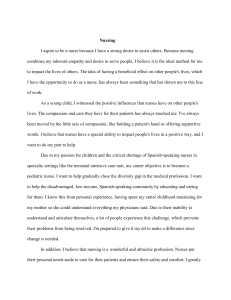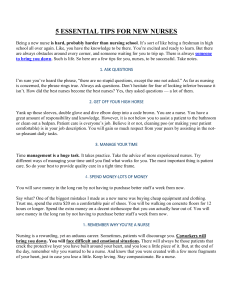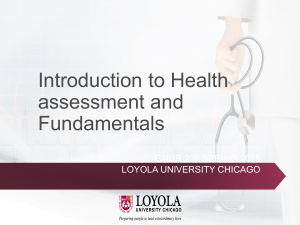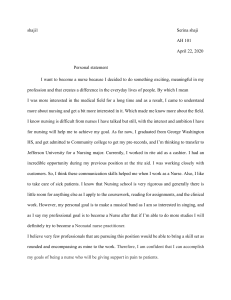Critical Thinking and the Nursing Process
advertisement
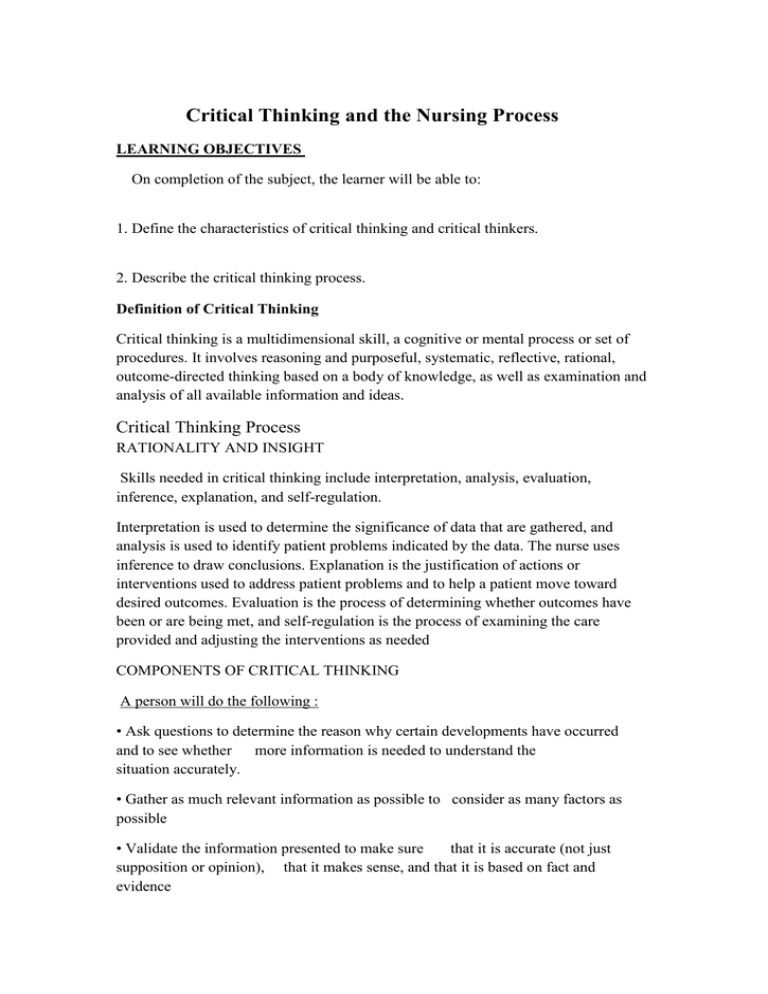
Critical Thinking and the Nursing Process LEARNING OBJECTIVES On completion of the subject, the learner will be able to: 1. Define the characteristics of critical thinking and critical thinkers. 2. Describe the critical thinking process. Definition of Critical Thinking Critical thinking is a multidimensional skill, a cognitive or mental process or set of procedures. It involves reasoning and purposeful, systematic, reflective, rational, outcome-directed thinking based on a body of knowledge, as well as examination and analysis of all available information and ideas. Critical Thinking Process RATIONALITY AND INSIGHT Skills needed in critical thinking include interpretation, analysis, evaluation, inference, explanation, and self-regulation. Interpretation is used to determine the significance of data that are gathered, and analysis is used to identify patient problems indicated by the data. The nurse uses inference to draw conclusions. Explanation is the justification of actions or interventions used to address patient problems and to help a patient move toward desired outcomes. Evaluation is the process of determining whether outcomes have been or are being met, and self-regulation is the process of examining the care provided and adjusting the interventions as needed COMPONENTS OF CRITICAL THINKING A person will do the following : • Ask questions to determine the reason why certain developments have occurred and to see whether more information is needed to understand the situation accurately. • Gather as much relevant information as possible to consider as many factors as possible • Validate the information presented to make sure that it is accurate (not just supposition or opinion), that it makes sense, and that it is based on fact and evidence • Analyze the information to determine what it means and to see whether it forms clusters or patterns that point to certain conclusions. Draw on past clinical experience and knowledge to explain what is happening and to anticipate what might hap next, acknowledging personal bias and cultural influences. • Maintain a flexible attitude that allows the facts to into account all possibilities. guide thinking and takes • Consider available options and examine each in terms of its advantages and disadvantages. • Formulate decisions that reflect creativity and independent decision making. CRITICAL THINKING IN NURSING PRACTICE Using Nurses must use critical thinking skills in all practice settings—acute care, ambulatory care, extended care, and in the home and community. Regardless of the setting, each patient situation is viewed as unique and dynamic. The unique factors that the patient and nurse bring to the health care situation are considered, studied, analyzed, and interpreted. Interpretation of the information presented then allows the nurse to focus on those factors that are most relevant and most significant to the clinical situation. Decisions about what to do and how to do it are then developed into a plan of action. Fonteyn (1998) identified 12 predominant thinking strategies used by nurses, regardless of their area of clinical practice: • Recognizing a pattern • Setting priorities • Searching for information • Generating hypotheses • Making predictions • Forming relationships • Stating a proposition (“if–then”) • Asserting a practice rule • Making choices (alternative actions) • Judging the value • Drawing conclusions • Providing explanations Critical thinking requires going beyond basic problem solving into a realm of inquisitive exploration, looking for all relevant factors that affect the issue, and being an “out-of-the-box” thinker. It includes questioning all findings until a comprehensive picture emerges that explains the phenomenon, possible solutions, and creative methods for proceeding (Wilkinson, 2001). Remember it is important to remember that each situation is unique and calls for an approach that fits the particular circumstances being described. Critical thinking in nursing practice results in a comprehensive patient plan of care with maximized potential for success.

